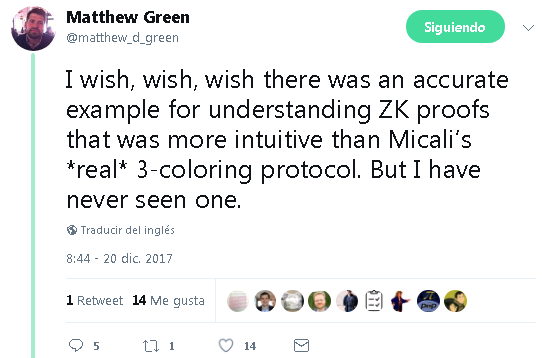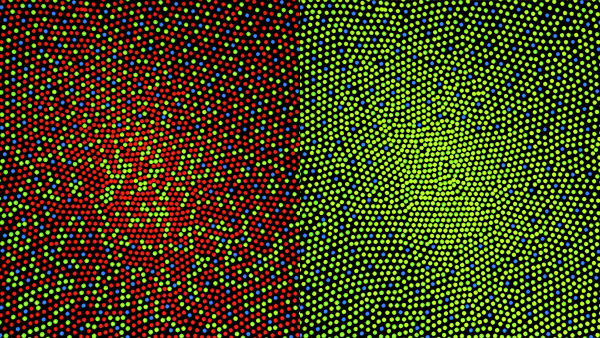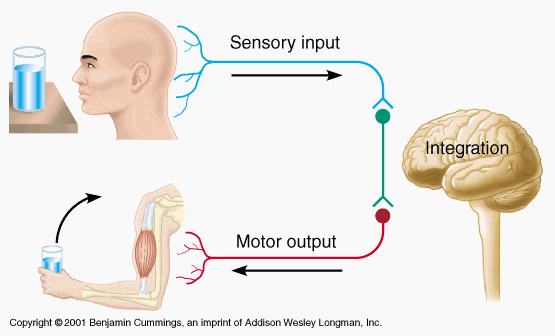
 Image: @iamhappytoast Can you hear this GIF?
Image: @iamhappytoast Can you hear this GIF?
Believe none of what you hear
and
Believe some of what you see
Minimizing trust in perception
By Juan SIlva @ertwro
Based on Dr. Matthew green's blog[1] and Dr. Elliot D. Freeman's[2] research

| Highlights: 1 → Visually Evoked Auditory Reponse: Our senses work together, in a multimodal fashion. Unreliable yet useful. 2 → Alterations in Perception: When the input of that stimuli is not clear artifacts appear 3 → Reflexes: There are different stages of feedback for such stimuli, all of them automated by optimization 4 → Zero knowledge proofs: A mathematical bypass for the implications of proving to someone who sees the world in a different way that something is true 5 → Conclussion |
||||||||
 vEAR n the opening gif I asked you if you could hear that gif. Around 70% people in a twitter survey responded that they can. This was made famous by Dr Lisa DeBruine who twitted about it.  This evoked response is a mild form of synesthesia. First described in 2008.[3] Not properly it but a reflex form of it. This is what is called a Visually-Evoked Auditory Response (vEAR). Are these people just agreeing on it or are they really hearing this? There are neurologic reasons for believing they actually do.[4] Neurologic feedback loops compete for a definite answer to multimodal sensory inputs. One everyday example of this is the McGurk effect, where the same piece of information is affected by the auditory stimuli being combined with a similar competing signal.[5]  The audio emited is the same through out the clip The audio emited is the same through out the clipWhat changes is the visual input. From Ba, to Pa, to Fa It has some interesting consequences. E.g. Desynchronizing audio from video as a learning tool. For instance, we know that delay in auditory stimuli helps improve comprehension. Useful in the case of people learning a new language.[6] We are sure this happens due to Electrophysiologic recordings of Visually evoked potentials. Evoked potentials are monitored the objective response of an individual to sensory stimuli. Like is the case for hearing loss or multiple sclerosis(Auditory Brainstem Response) and alteration in the visual pathway (Visually evoked potentials). Such tests would allow finding that a person indeed is observing such a thing. Although useful for us it would not help the patient on its own. Alterations in perception are far more common than people would normally realize.  Alterations in Perception
This is important in the sense of discussing from first principles. Even when someone experiences something that goes against their core beliefs if done in a way that allows for safe experimentation of decision making. Without engaging the person through interaction and thought experiments no learning and desensitization can occur. It must be gradual in order to build growing coordination.  Zero-Knowledge Proofs s like a magic trick in a theater. How do you know the magician and the person selected at random from the public are not colluding, that the person in the public is not actually a rival magician trying to steal the trick/ruin it in front of everyone else, that there's really a trick in the first place? From an observer's perspective, how could you trust the prover and the verifier? This is something that mathematicians solved back in 1985,[y] in the form of interactive proof systems with zero-knowledge. Later to advance in the form of non-interactive zero-knowledge; 3-coloring; Schnorr, Groth-Sahai, and zk-SNARKs. Zero-knowledge proofs are methods where one party can prove another interested actor that one statement is true without conveying different information to the fact the statement is true. Zero-Knowledge proofs:
One of the classic explanations on this subject is the 3 coloring scheme. You can find an in-depth intuitive review by Dr. Matthew green, but roughly speaking:
Although the context is different and an analogy might be an overstretch. When scientists teach non-experts that are skeptics or in denial of a subject, where the body of evidence is sound but is against the core of the verifier's interests, what the scientist hopes to perform is a zero-knowledge proof. Normally in a zero-knowledge proof, the prover has a bigger computational capacity and preparation than the verifier. He can't teach in minutes the years of evidence and expertise in order for the person to understand or accept the proofs. Yet he can share portions of the information that he wouldn't be able to obtain otherwise by faking it. 1 If the scientist is honest (appeals to nothing except evidence) he will eventually convince them 2 He can only convince them if the science is true 3 the person accepts the information as true regardless of how it affects their self-interests. The concept is so anti-intuitive that cryptographers struggle to find a good analogy.  Yet that's maybe the most telling aspect of this. Science is anti-intuitive. If someone lacks the ability to determine if something is true or not, there are still ways to approach this problem. Avoiding the pitfalls of triggering erroneous impulses or activating non-rational responses.  Conclussion here are many people that have strong opinions against choices based on science. Many stimuli trigger similar activation pathways, confounding the subject but he doesn't understand the confusion. Identifying the mixed signals and cleaning the channels of interaction is the first step. This is like an immune system response, but at the behavior, level rooted in the nervous system. Just like in the immune system desensitization is the first step to allow continuous exposure to a new element. We sometimes create more harm than good by engaging in conversations where computation from the verifier is limited. This is disingenuous and creates more harm in the long run. This desensitization only requires the verifier to bypass their senses and obtain the proof that what is being shared is true. Any further understanding will require resources from the verifier that now has a party he can trust a little more. Giving them the gift of experiencing reality in a little more vivid way.  REFERENCES: [1] Zero Knowledge Proofs: An illustrated primer. Matthew Green in fundamentals November 27, 2014. e-Pub [7]Hart, W. M., Jr. (1987). Acquired dyschromatopsias. Survey of Ophthalmology, 32(1), 10–31. [8]Gordon, N. (1998). Colour blindness. Public Health, 112(2), 81–84. # Some of my other posts:   
|












